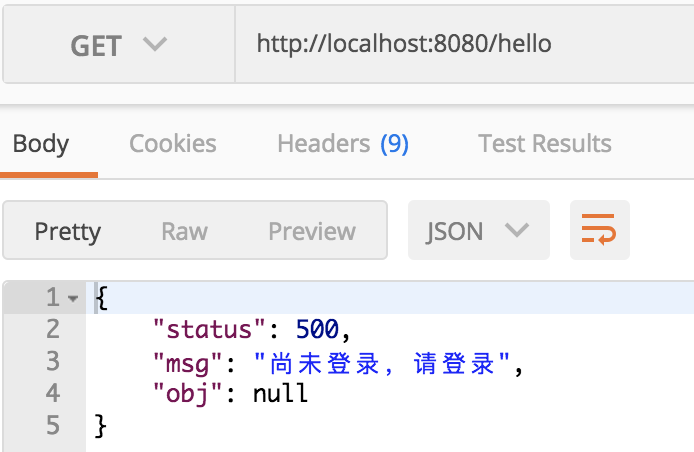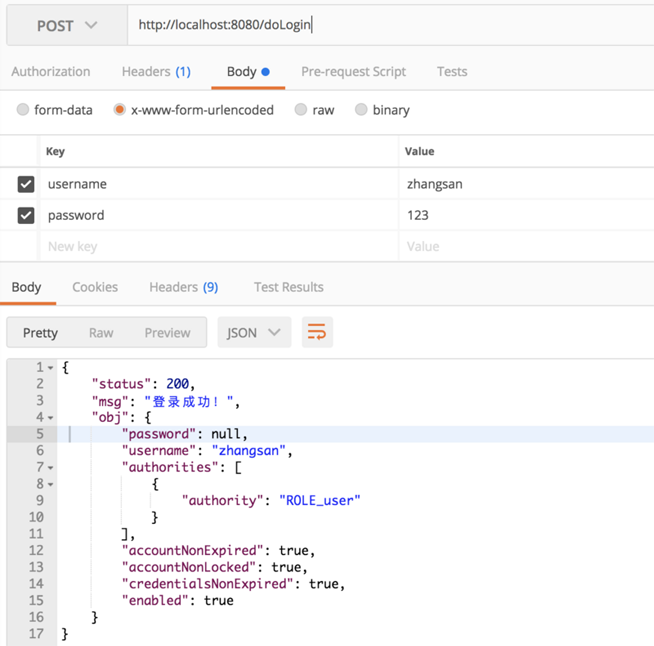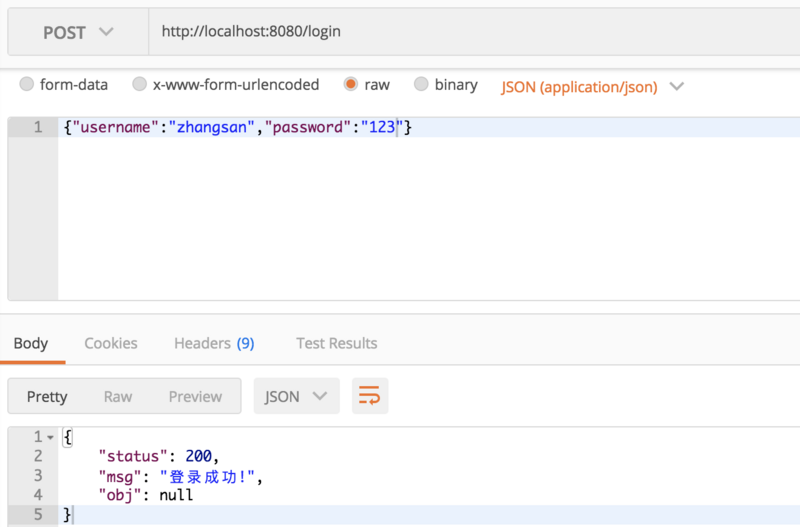这期内容当中小编将会给大家带来有关如何使用JSON格式数据登录SpringSecurity,文章内容丰富且以专业的角度为大家分析和叙述,阅读完这篇文章希望大家可以有所收获。
创建Spring Boot工程
首先创建SpringBoot工程,添加SpringSecurity依赖,如下:
<dependency> <groupId>org.springframework.boot</groupId> <artifactId>spring-boot-starter-security</artifactId> </dependency> <dependency> <groupId>org.springframework.boot</groupId> <artifactId>spring-boot-starter-web</artifactId> </dependency>
添加Security配置
创建SecurityConfig,完成SpringSecurity的配置,如下:
@Configuration
public class SecurityConfig extends WebSecurityConfigurerAdapter {
@Bean
PasswordEncoder passwordEncoder() {
return new BCryptPasswordEncoder();
}
@Override
protected void configure(AuthenticationManagerBuilder auth) throws Exception {
auth.inMemoryAuthentication().withUser("zhangsan").password("$2a$10$2O4EwLrrFPEboTfDOtC0F.RpUMk.3q3KvBHRx7XXKUMLBGjOOBs8q").roles("user");
}
@Override
public void configure(WebSecurity web) throws Exception {
}
@Override
protected void configure(HttpSecurity http) throws Exception {
http.authorizeRequests()
.anyRequest().authenticated()
.and()
.formLogin()
.loginProcessingUrl("/doLogin")
.successHandler(new AuthenticationSuccessHandler() {
@Override
public void onAuthenticationSuccess(HttpServletRequest req, HttpServletResponse resp, Authentication authentication) throws IOException, ServletException {
RespBean ok = RespBean.ok("登录成功!",authentication.getPrincipal());
resp.setContentType("application/json;charset=utf-8");
PrintWriter out = resp.getWriter();
out.write(new ObjectMapper().writeValueAsString(ok));
out.flush();
out.close();
}
})
.failureHandler(new AuthenticationFailureHandler() {
@Override
public void onAuthenticationFailure(HttpServletRequest req, HttpServletResponse resp, AuthenticationException e) throws IOException, ServletException {
RespBean error = RespBean.error("登录失败");
resp.setContentType("application/json;charset=utf-8");
PrintWriter out = resp.getWriter();
out.write(new ObjectMapper().writeValueAsString(error));
out.flush();
out.close();
}
})
.loginPage("/login")
.permitAll()
.and()
.logout()
.logoutUrl("/logout")
.logoutSuccessHandler(new LogoutSuccessHandler() {
@Override
public void onLogoutSuccess(HttpServletRequest req, HttpServletResponse resp, Authentication authentication) throws IOException, ServletException {
RespBean ok = RespBean.ok("注销成功!");
resp.setContentType("application/json;charset=utf-8");
PrintWriter out = resp.getWriter();
out.write(new ObjectMapper().writeValueAsString(ok));
out.flush();
out.close();
}
})
.permitAll()
.and()
.csrf()
.disable()
.exceptionHandling()
.accessDeniedHandler(new AccessDeniedHandler() {
@Override
public void handle(HttpServletRequest req, HttpServletResponse resp, AccessDeniedException e) throws IOException, ServletException {
RespBean error = RespBean.error("权限不足,访问失败");
resp.setStatus(403);
resp.setContentType("application/json;charset=utf-8");
PrintWriter out = resp.getWriter();
out.write(new ObjectMapper().writeValueAsString(error));
out.flush();
out.close();
}
});
}
}这里的配置虽然有点长,但是很基础,配置含义也比较清晰,首先提供BCryptPasswordEncoder作为PasswordEncoder,可以实现对密码的自动加密加盐,非常方便,然后提供了一个名为zhangsan的用户,密码是123,角色是user,最后配置登录逻辑,所有的请求都需要登录后才能访问,登录接口是/doLogin,用户名的key是username,密码的key是password,同时配置登录成功、登录失败以及注销成功、权限不足时都给用户返回JSON提示,另外,这里虽然配置了登录页面为/login,实际上这不是一个页面,而是一段JSON,在LoginController中提供该接口,如下:
@RestController
@ResponseBody
public class LoginController {
@GetMapping("/login")
public RespBean login() {
return RespBean.error("尚未登录,请登录");
}
@GetMapping("/hello")
public String hello() {
return "hello";
}
}这里/login只是一个JSON提示,而不是页面, /hello则是一个测试接口。
OK,做完上述步骤就可以开始测试了,运行SpringBoot项目,访问/hello接口,结果如下:

此时先调用登录接口进行登录,如下:

登录成功后,再去访问/hello接口就可以成功访问了。
使用JSON登录
上面演示的是一种原始的登录方案,如果想将用户名密码通过JSON的方式进行传递,则需要自定义相关过滤器,通过分析源码我们发现,默认的用户名密码提取在UsernamePasswordAuthenticationFilter过滤器中,部分源码如下:
public class UsernamePasswordAuthenticationFilter extends
AbstractAuthenticationProcessingFilter {
public static final String SPRING_SECURITY_FORM_USERNAME_KEY = "username";
public static final String SPRING_SECURITY_FORM_PASSWORD_KEY = "password";
private String usernameParameter = SPRING_SECURITY_FORM_USERNAME_KEY;
private String passwordParameter = SPRING_SECURITY_FORM_PASSWORD_KEY;
private boolean postOnly = true;
public UsernamePasswordAuthenticationFilter() {
super(new AntPathRequestMatcher("/login", "POST"));
}
public Authentication attemptAuthentication(HttpServletRequest request,
HttpServletResponse response) throws AuthenticationException {
if (postOnly && !request.getMethod().equals("POST")) {
throw new AuthenticationServiceException(
"Authentication method not supported: " + request.getMethod());
}
String username = obtainUsername(request);
String password = obtainPassword(request);
if (username == null) {
username = "";
}
if (password == null) {
password = "";
}
username = username.trim();
UsernamePasswordAuthenticationToken authRequest = new UsernamePasswordAuthenticationToken(
username, password);
// Allow subclasses to set the "details" property
setDetails(request, authRequest);
return this.getAuthenticationManager().authenticate(authRequest);
}
protected String obtainPassword(HttpServletRequest request) {
return request.getParameter(passwordParameter);
}
protected String obtainUsername(HttpServletRequest request) {
return request.getParameter(usernameParameter);
}
//...
//...
}从这里可以看到,默认的用户名/密码提取就是通过request中的getParameter来提取的,如果想使用JSON传递用户名密码,只需要将这个过滤器替换掉即可,自定义过滤器如下:
public class CustomAuthenticationFilter extends UsernamePasswordAuthenticationFilter {
@Override
public Authentication attemptAuthentication(HttpServletRequest request, HttpServletResponse response) throws AuthenticationException {
if (request.getContentType().equals(MediaType.APPLICATION_JSON_UTF8_VALUE)
|| request.getContentType().equals(MediaType.APPLICATION_JSON_VALUE)) {
ObjectMapper mapper = new ObjectMapper();
UsernamePasswordAuthenticationToken authRequest = null;
try (InputStream is = request.getInputStream()) {
Map<String,String> authenticationBean = mapper.readValue(is, Map.class);
authRequest = new UsernamePasswordAuthenticationToken(
authenticationBean.get("username"), authenticationBean.get("password"));
} catch (IOException e) {
e.printStackTrace();
authRequest = new UsernamePasswordAuthenticationToken(
"", "");
} finally {
setDetails(request, authRequest);
return this.getAuthenticationManager().authenticate(authRequest);
}
}
else {
return super.attemptAuthentication(request, response);
}
}
}这里只是将用户名/密码的获取方案重新修正下,改为了从JSON中获取用户名密码,然后在SecurityConfig中作出如下修改:
@Override
protected void configure(HttpSecurity http) throws Exception {
http.authorizeRequests().anyRequest().authenticated()
.and()
.formLogin()
.and().csrf().disable();
http.addFilterAt(customAuthenticationFilter(), UsernamePasswordAuthenticationFilter.class);
}
@Bean
CustomAuthenticationFilter customAuthenticationFilter() throws Exception {
CustomAuthenticationFilter filter = new CustomAuthenticationFilter();
filter.setAuthenticationSuccessHandler(new AuthenticationSuccessHandler() {
@Override
public void onAuthenticationSuccess(HttpServletRequest req, HttpServletResponse resp, Authentication authentication) throws IOException, ServletException {
resp.setContentType("application/json;charset=utf-8");
PrintWriter out = resp.getWriter();
RespBean respBean = RespBean.ok("登录成功!");
out.write(new ObjectMapper().writeValueAsString(respBean));
out.flush();
out.close();
}
});
filter.setAuthenticationFailureHandler(new AuthenticationFailureHandler() {
@Override
public void onAuthenticationFailure(HttpServletRequest req, HttpServletResponse resp, AuthenticationException e) throws IOException, ServletException {
resp.setContentType("application/json;charset=utf-8");
PrintWriter out = resp.getWriter();
RespBean respBean = RespBean.error("登录失败!");
out.write(new ObjectMapper().writeValueAsString(respBean));
out.flush();
out.close();
}
});
filter.setAuthenticationManager(authenticationManagerBean());
return filter;
}将自定义的CustomAuthenticationFilter类加入进来即可,接下来就可以使用JSON进行登录了,如下:

上述就是小编为大家分享的如何使用JSON格式数据登录SpringSecurity了,如果刚好有类似的疑惑,不妨参照上述分析进行理解。如果想知道更多相关知识,欢迎关注亿速云行业资讯频道。
免责声明:本站发布的内容(图片、视频和文字)以原创、转载和分享为主,文章观点不代表本网站立场,如果涉及侵权请联系站长邮箱:is@yisu.com进行举报,并提供相关证据,一经查实,将立刻删除涉嫌侵权内容。